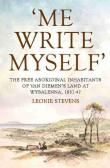 3753601768975410773.jpg
3753601768975410773.jpg
 'Me Write Myself' : The Free Aboriginal Inhabitants of Van Diemens Land at Wybalenna, 1832-47
multi chapter work
'Me Write Myself' : The Free Aboriginal Inhabitants of Van Diemens Land at Wybalenna, 1832-47
multi chapter work
 3753601768975410773.jpg
3753601768975410773.jpg
 'Me Write Myself' : The Free Aboriginal Inhabitants of Van Diemens Land at Wybalenna, 1832-47
multi chapter work
'Me Write Myself' : The Free Aboriginal Inhabitants of Van Diemens Land at Wybalenna, 1832-47
multi chapter work
Exiles, lost souls, remnants of a dying race. The fate of the First Nations peoples of Van Diemen's Land is one of the most infamous chapters in Australian, and world, history. The men, women, and children exiled to Flinders Island in the 1830s and 40s have often been written about, but never allowed to speak for themselves. This book aims to change that. Penned by the exiles during their fifteen years at the settlement called Wybalenna, items in the Flinders Island Chronicle, sermons, letters, and petitions offer a compelling corrective to traditional portrayals of a hopeless, dispossessed, illiterate people's final days.
The exiles did not see themselves as prisoners, but as a Free People. Seen through their own writing, the community at Wybalenna was vibrant, complex, and evolving. Rather than a depressed people simply waiting for death, their own words reveal a politically astute community engaged in a fifteen year campaign for their own freedom: one which was ultimately successful. This is a compelling story that will profoundly affect understandings of Tasmanian and Australian history.' (Publication summary)
'Entering a crowded and contested field of history requires the type of pluck and vision demonstrated by Leonie Stevens in Me Write Myself. This compelling intervention in Indigenous Australian history recounts the exile experience of Van Diemen’s Land First Nations Peoples at Wybalenna Aboriginal Establishment on Flinders Island in Bass Strait, 1832–47. Focusing upon the years immediately after the frontier wars, Stevens brings voice to ‘documents and perspectives which were previously all but silenced’ (xxxiv). This approach revises a canonical historical narrative characterised by ‘Eurocentrism and hierarchical thinking’ (252). Stevens illuminates the writings, world views and hopes of the exiles. In doing so, she critiques and corrects a historiographical record that has focused on the actions and accounts of Europeans from James Bonwick’s (1870) The Last of the Tasmanians through to Brian Plomley’s (1987) Weep in Silence and beyond.' (Introduction)
'As Leonie Stevens points out in her introduction, there is already an extensive historiography on the Aboriginal settlement named Wybalenna, on Flinders Island off the coast of Van Diemen's Land (VDL), which lasted from 1832 to 1847. The community, established to hold in one place the remaining and seriously threatened Indigenous population of VDL, was never large. It reached a peak of between 150 and 200 people in 1834, and although the settlement was occasionally augmented by later arrivals, the dramatic excess of deaths over births meant that by 1847, when the settlement closed, its population had dropped to forty-three. This population decline, which continued when the community was removed to Oyster Cove on the VDL mainland, led observers at the time and since to see this as a case of human extinction in the face of colonisation. It has been quite common to see the story of the Aboriginal settlement on Flinders Island, then, as one of demoralisation and despair, of a people awaiting their relentless decline and inevitable demise.' (Introduction)
'As Leonie Stevens points out in her introduction, there is already an extensive historiography on the Aboriginal settlement named Wybalenna, on Flinders Island off the coast of Van Diemen's Land (VDL), which lasted from 1832 to 1847. The community, established to hold in one place the remaining and seriously threatened Indigenous population of VDL, was never large. It reached a peak of between 150 and 200 people in 1834, and although the settlement was occasionally augmented by later arrivals, the dramatic excess of deaths over births meant that by 1847, when the settlement closed, its population had dropped to forty-three. This population decline, which continued when the community was removed to Oyster Cove on the VDL mainland, led observers at the time and since to see this as a case of human extinction in the face of colonisation. It has been quite common to see the story of the Aboriginal settlement on Flinders Island, then, as one of demoralisation and despair, of a people awaiting their relentless decline and inevitable demise.' (Introduction)
'Entering a crowded and contested field of history requires the type of pluck and vision demonstrated by Leonie Stevens in Me Write Myself. This compelling intervention in Indigenous Australian history recounts the exile experience of Van Diemen’s Land First Nations Peoples at Wybalenna Aboriginal Establishment on Flinders Island in Bass Strait, 1832–47. Focusing upon the years immediately after the frontier wars, Stevens brings voice to ‘documents and perspectives which were previously all but silenced’ (xxxiv). This approach revises a canonical historical narrative characterised by ‘Eurocentrism and hierarchical thinking’ (252). Stevens illuminates the writings, world views and hopes of the exiles. In doing so, she critiques and corrects a historiographical record that has focused on the actions and accounts of Europeans from James Bonwick’s (1870) The Last of the Tasmanians through to Brian Plomley’s (1987) Weep in Silence and beyond.' (Introduction)